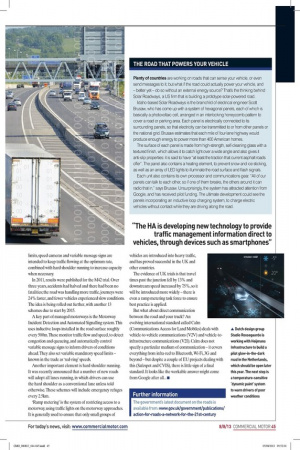Plenty of countries are working on roads that can sense
Page 38

If you've noticed an error in this article please click here to report it so we can fix it.
your vehicle, or even send messages to it; but what if the road could actually power your vehicle, and — better yet— do so without an external energy source? That's the thinking behind Solar Roadways, a US firm that is building a prototype solar-powered road.
Idaho-based Solar Roadways is the brainchild of electrical engineer Scott Brusaw, who has come up with a system of hexagonal panels, each of which is basically a photovoltaic cell, arranged in an interlocking honeycomb pattern to cover a road or parking area. Each panel is electrically connected to its surrounding panels, so that electricity can be transmitted to or from other panels or the national grid. Brusaw estimates that each mile of four-lane highway would produce enough energy to power more than 400 American homes.
The surface of each panel is made from high-strength, self-cleaning glass with a textured finish, which allows it to catch light over a wide angle and also gives it anti-slip properties: it is said to have "at least the traction that current asphalt roads offer". The panel also contains a heating element, to prevent snow and ice sticking, as well as an array of LED lights to illuminate the road surface and flash signals.
Each unit also contains its own processor and communications gear. "All of our panels can talk to each other, so if one of them breaks, the others around it can radio that in," says Brusaw. Unsurprisingly, the system has attracted attention from Google, and has received pilot funding. The ultimate development could see the panels incorporating an inductive loop charging system, to charge electric vehicles without contact while they are driving along the road.









































